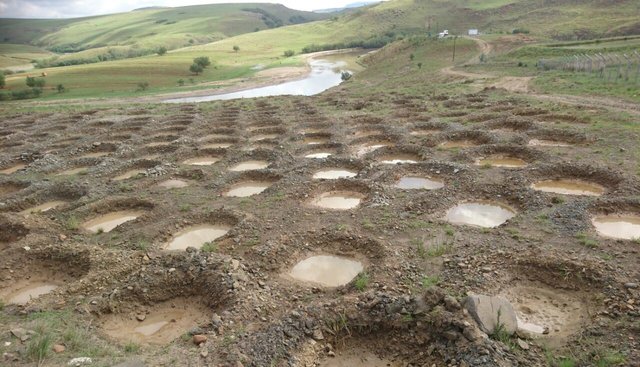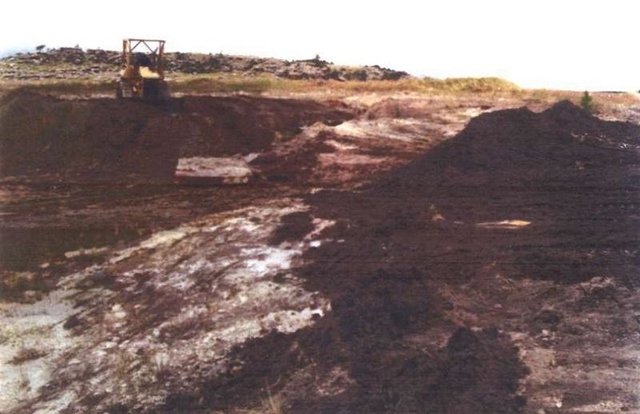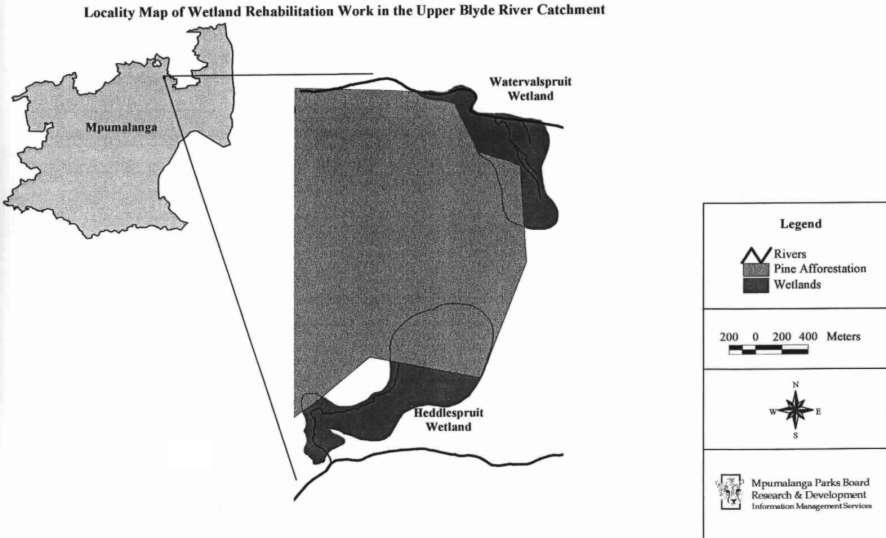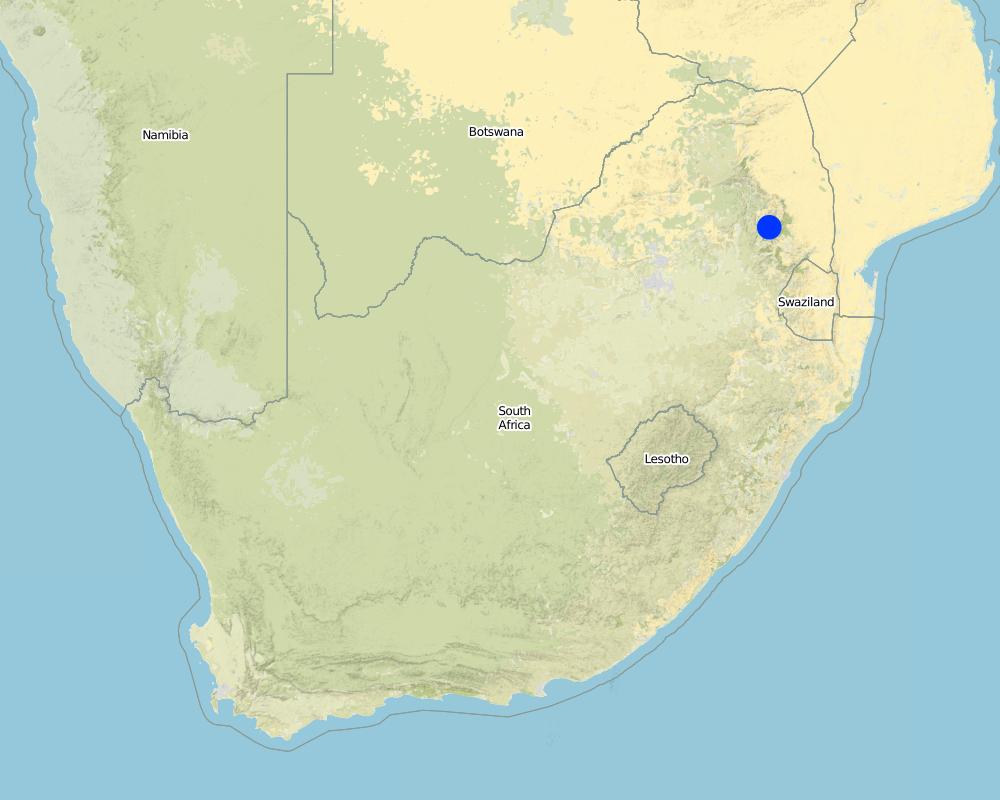Working for Water Wetland rehabilitation [南非]
- 创建:
- 更新:
- 编制者: Unknown User
- 编辑者: –
- 审查者: Fabian Ottiger
approaches_2414 - 南非
查看章节
全部展开 全部收起1. 一般信息
1.2 参与方法评估和文件编制的资源人员和机构的联系方式
关键资源人员
SLM专业人员:
Bronkhorst Frik
南非
SLM专业人员:
Landström Anton
013 23 52 395
Mpumalanga Parks Board, P.O. Box 4442, Lyndenburg 1120,
南非
1.3 关于使用通过WOCAT记录的数据的条件
编制者和关键资源人员接受有关使用通过WOCAT记录数据的条件。:
是
1.4 SLM技术问卷的参考

Pitting to restore degraded catchment of Mount Fletcher … [南非]
To improve infiltration and vegetation cover, by creating small pits on bare soil, which capture runoff and reduce erosion.
- 编制者: Dirk Pretorius

Wetland rehabilitation [南非]
To rehabilitate/stabilise distorted wetlands as close as possible to its original state/function.
- 编制者: Unknown User
2. SLM方法的描述
2.1 该方法的简要说明
To improve the quality & quantity of water production and biodiversity in the Blyde River catchment area.
2.2 该方法的详细说明
该方法的详细说明:
Aims / objectives: Stabilise, landscape and re-vegetate degraded wetlands in the upper Blyde River catchment. The objective was to re-instate the previous water table and vegetation by slowing down run-off through the building of gabions, landfills, reshaping and hydroseeding. Participants: Government funding
2.3 该方法的照片
2.5 采用该方法的国家/地区/地点
国家:
南非
区域/州/省:
Mpumalanga
Map
×2.6 该方法的开始和终止日期
注明开始年份:
1999
2.7 方法的类型
- 基于项目/方案
2.8 该方法的主要目的/目标
The Approach focused mainly on SLM with other activities (Catchment management)
To rehabilitate degraded wetlands in the upper Blyde Rive catchment area To employ jobless people in adjacent local community
The SLM Approach addressed the following problems: Stopping head-cut erosion, landscape old mine trenches, re-vegetate area of bare soil, re-visit burning programme
2.9 推动或妨碍实施本办法所适用的技术的条件
社会/文化/宗教规范和价值观
- 阻碍
Ignorance of forestry, mining & local communities about the importance of these natural systems
Treatment through the SLM Approach: Capacity building & extension work
财务资源和服务的可用性/可得性
- 阻碍
Rehabilitation is an 'extra' workload. Current budget does not allow for this
Treatment through the SLM Approach: External funding: Working for Water, Landcare
法律框架(土地使用权、土地和水使用权)
- 启动
The existing land ownership, land use rights / water rights greatly helped the approach implementation: Both sites where work has been done is on conservation land
- 阻碍
Powerless to address illegal activities
Treatment through the SLM Approach: Inadequate policing
了解SLM,获得技术支持
- 阻碍
Not much is known on rehabilitation in this veld type
Treatment through the SLM Approach: Use this as an opportunity to build up information
3. 相关利益相关者的参与和角色
3.1 该方法涉及的利益相关者及其职责
- 当地土地使用者/当地社区
Specific ethnic groups: Previously disadvantage communities
Specialist in this field are mainly men
- SLM专家/农业顾问
- 国家政府(规划者、决策者)
Several government departments; working for water
如果涉及多个利益相关者,请注明领导机构:
Frik Bronkhorst, Anton Linström (Business plan, layout of rehabilitation work), Peter Steyn (landscaping, employment)
3.2 当地土地使用者/当地社区参与该方法的不同阶段
| 当地土地使用者/当地社区的参与 | 指定参与人员并描述活动 | |
|---|---|---|
| 启动/动机 | 无 | survey; Wetland condition survey identified these two wetlands as priorities for rehabilitation work |
| 计划 | 无 | consultation; Inputs of various specialists were used to draw up a business plan |
| 实施 | 外部支持 | Contractor, casual labour; Landscaping contractor was employed to implement business plan |
| 监测/评估 | 被动 | reporting, measurements/observations; Fixed point photography & vegetation transects, water quality tests. Report is available |
| Research | 无 |
3.4 有关SLM技术选择的决策
具体说明谁有权决定选择要实施的技术:
- 主要是土地使用者,由SLM专家提供支持
解释:
consultative. Also land user driven Land-users (Mpumalanga Parks Board with advice from Frik Bronkhorst). Men make decisions, no women in the specific posts.
Decisions on the method of implementing the SLM Technology were made by mainly by land users supported by SLM specialists. consultative. Also land user driven
4. 技术支持、能力建设和知识管理
4.1 能力建设/培训
是否为土地使用者/其他利益相关者提供培训?:
是
- SWC specialists
培训形式:
- 在职
- 示范区域
涵盖的主题:
Rehabilitation and importance of the wetland ecosystem in water management
4.2 咨询服务
土地使用者有权使用咨询服务吗?:
是
指明是否提供了咨询服务:
- 在固定中心
说明/注释:
Name of method used for advisory service: Mpumalanga Wetland Project, Mpumalanga Parks Board; Key elements: Capacity building among land users, Wetland conservation, Wetland rehabilitation; 1) Advisory service was carried out through: government's existing extension system. Extension staff: mainly government employees 2) Target groups for extension: land user
Advisory service is quite adequate to ensure the continuation of land conservation activities; Got the expertise and gained much from this activity to contribute
4.3 机构强化(组织发展)
是否通过这种方法建立或加强了机构?:
- 是,少许
具体说明机构的强化或建立程度:
- 本地
具体说明支持类型:
- 能力建设/培训
4.4 监测和评估
监测和评估是该方法的一部分吗?:
是
注释:
bio-physical aspects were regular monitored through measurements
technical aspects were regular monitored through measurements
There were no changes in the Approach as a result of monitoring and evaluation
4.5 研究
研究是该方法的一部分吗?
是
明确话题:
- 生态学
提供进一步的细节,并指出是谁做的研究:
Vegetation transects to monitor dynamics, fixed point photographs, water quality tests
Research was carried out both on station and on-farm
5. 融资和外部物质支持
5.1 该方法中SLM组成部分的年度预算
如果不知道准确的年度预算,请给出一个范围:
- 10,000-100,000
注释(例如主要的资助来源/主要捐助者):
Approach costs were met by the following donors: government (national): 100.0%
5.2 为土地使用者提供财政/物质支援
土地使用者是否获得实施该技术的财政/物质支持?:
否
5.3 对特定投入的补贴(包括劳动力)
如果土地使用者的劳动力是一项重要的投入,那么是不是:
- 自愿
注释:
Parks Board officials/advisory, supervision & monitoring
5.4 信用
是否根据SLM活动的方法给予信用值?:
否
6. 影响分析和结论性陈述
6.1 方法的影响
该方法是否帮助土地使用者实施和维护SLM技术?:
- 否
- 是,很少
- 是,中等
- 是,支持力度很大
Too early to comment Project has only just finished
6.3 方法活动的可持续性
土地使用者能否维持通过该方法实施的措施(无外部支持的情况下)?:
- 是
6.4 该方法的长处/优点
| 编制者或其他关键资源人员认为的长处/优势/机会 |
|---|
| Job creation (How to sustain/ enhance this strength: Governmental funding) |
| Working for water principle (How to sustain/ enhance this strength: Governmental funding) |
| Opportunity to be exposed to the practical side of wetland rehabilitation (How to sustain/ enhance this strength: Rehabilitation of others wetlands and monitoring the present situation) |
| Contribute towards the natural hydrological regime of the catchment (How to sustain/ enhance this strength: Monitoring) |
| Opportunity for land users to combine ideas and to improve relationships (How to sustain/ enhance this strength: Work towards a better environment) |
6.5 该方法的弱点/缺点以及克服它们的方法
| 编制者或其他关键资源人员认为的弱点/缺点/风险 | 如何克服它们? |
|---|---|
| No action from a steering committee | Get steering committee up and going |
| Lack of practical experiences on wetland rehabilitation | Get more experiences |
7. 参考和链接
7.1 方法/信息来源
- 实地考察、实地调查
- 与土地使用者的访谈
链接和模块
全部展开 全部收起链接

Pitting to restore degraded catchment of Mount Fletcher … [南非]
To improve infiltration and vegetation cover, by creating small pits on bare soil, which capture runoff and reduce erosion.
- 编制者: Dirk Pretorius

Wetland rehabilitation [南非]
To rehabilitate/stabilise distorted wetlands as close as possible to its original state/function.
- 编制者: Unknown User
模块
无模块





